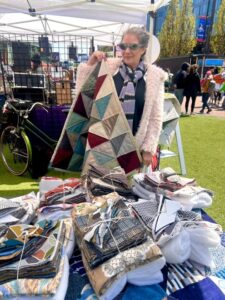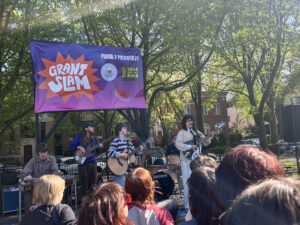Music-to-color association, known as chromesthesia, is a common correlation that defines relating various overlapping elements of music, such as wavelength and tempo, to the elements of color, according to i-Perception. Chromesthesia was a topic of conversation during The Night Market at WNDR Museum on Thursday, March 21.

“I love listening to Earth, Wind & Fire because I grew up listening to them with my dad,” said artist Katie Barnett, 32, of Chicago. “When I think of the song ‘September,’ I just picture a tangerine orange or a burnt red; I don’t know if it’s a funk aspect or if my brain is just thinking of September.”
A connection to the musician behind the songs also yields color association results that may be associated with a particular genre — such as silver for disco, or blue for R&B. For Vintage Royalty founder and designer Meena Osei-Kuffour, connection goes beyond simple melodies to the passion the artist displays in their work.
“It’s so interesting how SZA did this Princess Diana [reference] where she is using the hues of blue to show the loneliness she probably felt while making her album,” she said. “I think my favorite from her last album was ‘Forgiveless’ with Ol’ Dirty Bastard, and I would say the color would be like a dark green, like almost deep-black color.”
Color-to-music associations differ by person. A color that may be shown as cheerful to one person may convey another meaning to someone with a different listening palette. Neither perception is right or wrong. Each person’s association varies depending on their familiarity with the song and the color together.

Reformed School shop owner and creator Peter Gaona said he finds the single “Forget Me Nots” by jazz pianist and R&B singer Patrice Rushen to have a silkiness to it, like crepe back satin.
“I feel like purple with that song,” he said. “Not like a deep sad purple, but maybe something more smooth like lavender.”
Musicians, artists and avid music listeners can associate color to sound through a broad range of emotionally driven connections between mediums. Colors often trigger emotional responses that vary from person to person, and each color comes with a certain mood, as Vice reports. By associating memories with reactions, synesthetes can feel color in the same way as emotion.
“Stevie Wonder is a great example of someone who experiences this since he’s blind and can’t read music, he connects color with emotion to form melodies on his piano,” Barnett said. “I think it’s just really cool how so many different personalities and artists can come together and experience emotions tied to different musical pieces.”







Be First to Comment